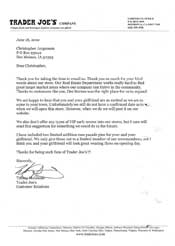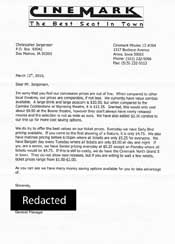Dear Sen. Grassley (IA)
Christopher L. Jorgensen
P.O. Box 546
Ames, IA 50010
April 29, 2008
Sen. Chuck Grassley
135 Hart Senate Bldg.
Washington, DC 20510-1501
Dear Senator Grassley,
Anyway I could get an autographed photo for my girlfriend? Just make it out to “
Redacted,
” if you would, please. Thanks!
Also, recently you were quoted in the media as making the following statement:
“If part of our problem is that the Chinese are going to eat meat and you’ve got to have corn and soybeans to feed the Chinese their meat, then why isn’t it just as legitimate for the Chinese to go back and eat rice as it is for us to change our policy on corn to ethanol?”
So I decided to do a little research and find out if the Chinese were indeed eating more meat, and was shocked to discover they eat dog meat! They call these “Food Dogs,” and as horrifying as I found this idea, it got me to thinking. Really there is no difference between eating dog and eating cow, pig, or horse!
Maybe this is the solution. If your office could promote a “meat breed,” of dog the Chinese might start eating MORE dog. They could even come up with their own version of the American dream, “A puppy in every pot and a rickshaw outside every straw hut.”
One of the websites I looked at said Saint Bernards are fast growing and disease resistant. They also eat less, and breed fast. This seems like the ideal dog for you to promote. You could also consider the Yorkie. This dog would make a great appetizer.
Seems like a win win to me. We get to keep our ethanol, and the Chinese get more meat. We’d have another great product to export, and the Iowa farmer could get rich off puppy mills!
Thanks,
Christopher L. Jorgensen
p.s. you’re the only Republican I’ve ever voted for (I think).
Reply:
United States Senate
Charles E. Grassley
Washington, DC 20510-1501
June 27, 2008
Christopher L. Jorgensen
P.O. Box 546
Ames, IA 50010
Dear Mr. Jorgensen:
Thank you for taking time to contact me. As your senator, it is important for me to hear from you.
I appreciate hearing your thoughts regarding the high price of food and your thoughts regarding the use of ethanol as a renewable motor fuel. For almost 30 years, I have been leading an effort with many of my colleagues to promote policies to grow a domestic renewable fuels industry. We have promoted homegrown renewable fuels as a way to lessen our dependence on foreign oil and to improve our air quality.
I have heard the argument about the effect of corn ethanol on domestic and global food prices. Food prices are going up. Of course, we all have to be sympathetic to that, whether it is in America or abroad. People struggling with higher prices for food is not something we like to hear. However, to put all the blame at the feet of the U.S. ethanol industry is misplaced.
With regard to wheat, rice, and lentils, economists indicate that the global demand for food from a growing middle-class in China and India has had the most impact. Weather trends, including a historic drought in Australia and poor growing conditions in Southeast Asia and Eastern Europe have had a much greater impact on the supply of rice and wheat. The truth is, global demand and prices for all commodities have increased.
One of the biggest reasons for rising food prices is the rising cost of oil. A recent Texas A&M study concluded that the biggest driving force behind the higher food costs is higher energy costs. Iowa State University’s Center for Agriculture and Rural Development has stated that without the ethanol we have, you would be paying 30 to 40 cents more for a gallon of gasoline. Since Texas A&M says energy is the biggest reason for the increased costs of food, you would have yet higher food prices without having ethanol.
Joseph Glauber, chief economist at the U.S. Department of Agriculture, recently testified that rising prices for corn and soybeans have had little or no effect on the high price for wheat, rice, and other food commodities. Dr. Glauber cited worldwide economic growth, global weather problems, rising marketing costs, and a weak U.S. dollar as having a greater role than biofuels in the cost of food being higher and even being scarce.
U.S. farmers responded to these increased demands for grain and produced a record corn crop in 2007. We grew more acres of corn in 2007 than any year since 1944. We produced 2.7 billion more bushels of corn in 2007 than 2006. Out of those 2.7 billion bushels, the growth in ethanol demand only used the equivalent of 600 million of them. Those who are concerned about not having enough corn need to take into consideration the 2.1 billion bushels more that we raised that was not used for ethanol.
Exports have grown as well. The U.S. Department of Agriculture estimates that this year’s corn exports will be a record 2.5 billion bushels. This is up 18 percent over last year. We are getting that surplus production in the United States around the world where it is needed. One of the places it is needed is in China. They do not export corn anymore. In the 1980s, the Chinese were eating 44 pounds of meat a year. The most recent data shows the Chinese are now eating 111 pounds of meat a year. They are going from rice to value-added food products. They need some of our corn to do that and we are glad to sell it to them.
With these facts, it is hard to argue that the domestic ethanol industry is diverting corn from feed or food markets. It is also important to keep in mind that a tiny fraction of the cost of retail food is the result of farm inputs.
According to the USDA, just 19 cents of every consumer dollar spent on food can be attributed to the actual cost of food inputs like grains. A standard box of corn cereal contains approximately 10 ounces, or 1/90th of a bushel of corn. If a bushel of corn is worth $4, a box of cereal has less than a nickel’s worth of corn. In meat production, 3.6 pounds of corn is needed to produce one pound of pork. At $3.50 per bushel for corn, the cost to produce one pound of pork is a mere 22.5 cents.
The truth is that ethanol is reducing our dependence upon foreign oil. Ethanol has a significant net energy balance. The same cannot be said for gasoline. Ethanol is reducing our greenhouse gas emissions. Ethanol is not the reason for rising food and feed prices here at home or abroad. Ethanol is lowering the price of crude oil and lowering the price of gasoline. Ethanol is increasing our national security, helping our balance of trade, reducing our dependence upon Middle East oil and the whims of big oil.
Again, thank you for contacting me. I appreciate hearing your views and urge you to keep in touch.
Sincerely,
[signed with autopen]
Charles E. Grassley
United States Senator
CEG/cs
Commentary:
Have a comment? Put a stamp on an envelope and drop it in the mail to:
Christopher L. JorgensenPO Box 546
Ames, IA 50010
Be sure to mention what letter your comment applies to. Adding some cash with your correspondence is a good thing. You can email me at .(JavaScript must be enabled to view this email address) if you must.
Latest Replies:
Other points of interest:
Legal:











Note: Address has been updated to reflect my current P.O. Box.
If you don’t eat your meat, you can’t have any pudding! How can you have any pudding if you don’t eat your meat! Pink Floyd, “The Wall.”
First off, Senator Grassley, your letter: Yawn yawn yawn!
Even Bill O’Reilly wants you to “keep it pithy if you want to opine,” and he’s one of you right wingers! Two pages for my ADD addlepated brain to take in? I’m one of them uneducated social program loving Independents. You can’t really expect me to read two whole pages of single spaced text! Boy am I glad I have a typist/girlfriend/editor or your letter would have never made it on these here internets!
I am so disappointed in you. Mostly because of the original asinine quote. As a Senator of an agricultural state that exports pork and beef to China why would you even suggest they go back to a rice based diet? I know lately it seems like we could grow rice in Iowa, but check in with a farmer once in a while. We can’t.
I wrote a nearly identical letter to the American Kennel Club. They didn’t respond.
By Christopher L. Jorgensen
Website: http://jackassletters.com